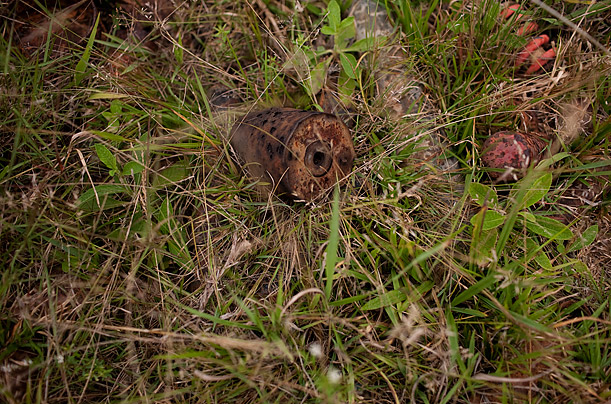The Bombs Left Behind in Laos

The Vietnam War ran for nearly twenty years, from late 1955 until the spring of 1975. While most of the fighting occurred in Vietnam (no surprise there), other nations — most notably Cambodia and Laos — were also part of the theater of war. Laos, in particular, was the scene of an intense bombing campaign by the U.S. military; the U.S. was hoping to disrupt the Viet Cong supply lines while simultaneously supporting the Laotian monarchy against communist rebels. According to the Legacies of War project, “from 1964 to 1973, the U.S. dropped more than two million tons of ordnance [another word for “explosives”] on Laos during 580,000 bombing missions—equal to a planeload of bombs every 8 minutes, 24-hours a day, for 9 years – making Laos the most heavily bombed country per capita in history.”
Today, some of those bombs are the basis for potentially lucrative but very dangerous employment in the area.
Many Laotians have very agrarian lives, living on the equivalent of a few dollars (as little as $2) a day earned by growing rice. Even simple tools are hard to come by in part because the metal needed to make them is relatively expensive at about 5 cents per pound. On the flip side, finding a large piece of metal can be a major economic boon. Per NPR, a 2,000 pound haul can warrant a $100 payday, and those amounts are more common than you’d think, because bomb casings from leftover U.S. ordnance weigh about that much. It is therefore unsurprising that many in Laos scavenge for the metal from leftover bombs, such as the one seen below (via TIME).

The good news is that the U.S. military dropped an estimated 270 million bombs during the war, so there is a lot of scrap to be found. This has had a huge impact on the economy. As Global Post reported in 2010, “villagers turn scrap into tools and utensils — everything from bowls to buckets, boats, spoons, knives, hoes, troughs, ladders, planters, cowbells, stilts and pedestals for satellite dishes.”
The bad news — the very bad news — is that approximately 30% of those bombs failed to explode at the time they were dropped, and are therefore potentially live. Called UXO — “unexploded ordnance” — these cluster bombs are liable to go off if disturbed.
The cluster bombs are responsible for approximately 20,000 deaths and injuries to date, with the injuries often resulting in the need for orthotic and prosthetic devices throughout the nation. (If you’re interested, you can donate a leg to someone in need for $75.) Many farmers working in the fields on their crops — not looking for metal — often run into a hidden UXO with terrible results. And many others are injured while explicitly looking for and handling UXO, hoping to cash out. Education is a large part of the efforts to stem the tide of these accidents; again via TIME, children educate one another on the dangers of picking up scrap metal via puppet shows and songs, with lyrics of warning. (“Be careful before you go out and play. if you see a bombie do not touch it,” is a common refrain.) Unfortunately, the economic allure of striking pay dirt is often too difficult — and too necessary — to avoid, so UXO collection continues. As the Guardian reported in 2008, “for those unable to grow enough rice to feed their families throughout the year, there is little choice but to collect UXO scrap despite the dangers.”
There’s an international effort underway to help, but its effectiveness is mixed. In 2008, many nations entered into the Convention on Cluster Munitions, an agreement to not only stop the use of cluster bombs (starting in 2010), but also to rehabilitate those areas affected by bombings from generations past. Unfortunately, the process is slow-going and requires more funding. As of 2014, the United States is donating $12 million annually to the efforts, a significant increase over previous years’ amounts but still much less than needed (and much less than the cost to bomb Laos in the first place). The New York Times estimated that the world will be donating a total of $40 million toward UXO removal in Laos in 2015, but also estimates that “it will be decades before all the unexploded bombs are removed from the Laotian countryside.”
 Bonus Fact: Laos is one of five nations with monosyllabic names in English. The other four: Chad, Spain, Greece, and France.
Bonus Fact: Laos is one of five nations with monosyllabic names in English. The other four: Chad, Spain, Greece, and France.
From the Archives: Unseen Animal: The closest thing we have to a unicorn lives in Laos. We think.
Take the Quiz: Five different countries border Laos. Name them. Too easy? Okay: Nineteen nations border the five nations that border Laos. Name them! (Hint: one of them is Laos.)
Related: “Eternal Harvest: The Legacy of American Bombs in Laos,” a book of photojournalism covering the Laotian countryside. 4.9 stars on 7 reviews.
